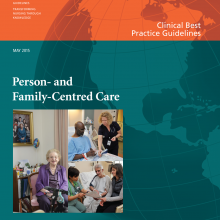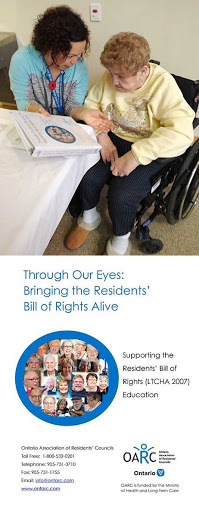How can we provide the best possible care to our residents? How do we create a person-centred culture respecting the resident as an individual with unique needs and goals? As individuals, if we look to those around us, we soon recognize we all have unique routines and needs. We may prefer to get up at different times in the morning, have our own distinctive priorities throughout the day, and have particular expectations of those around us.
By Freda Poirier,, RN, BScN, GNC(C), LTC best practice co-ordinator
RNAO’s guideline on Person- and Family-Centred Care (2015) was created to support health-care professionals to form and sustain true partnerships. Partnering and collaborating with other care providers, and more directly with residents and their families, provides the resident with more autonomy to make decisions, and ultimately improves satisfaction with their care. In the PFCC guideline, the expert panel identified four common themes required to support and influence these partnerships: establishing a therapeutic relationship for true partnership; continuity of care and shared decision making; care is organized around and respectful of the person, and; knowing the whole person and communication, collaboration and engagement.


In 2018, RNAO and the Ontario Association of Residents’ Councils (OARC) partnered to support the implementation of both the RNAO's Person- and Family-Centred Care (PFCC) BPG, and OARC’s Through Our Eyes: Bringing the Residents’ Bill of Rights Alive program (OARC, 2007). The OARC program aligns with the recommendations outlined in the PFCC guideline and guides long-term care home team members and residents to co-develop and co-facilitate education sessions about residents’ rights. Together, these programs work to complement evidence-based recommendations and facilitate participation from residents, family members, and the whole home. The goal is to improve residents’ and families’ experience of health care and the Residents’ Bill of Rights (LTCHA, 2007).
Through this partnership and collaboration, numerous long-term care homes across the province have recognized the impact of a focus on person and family centred care through the implementation of the PFCC guideline and OARC's program. RNAO’s LTC best practice co-ordinators across Ontario are promoting, coaching and cheering on the homes to implement this approach as it truly does reflect resident-centred care. It brings the voice of the resident to staff, gives respect to residents’ rights, and engages team members at the home.
According to activation aide Sandi Campbell from the F.J. Davey LTC home in Sault Ste. Marie, “the program really helps re-align us to the true reason we are here, why we chose to work in this sector. It is all about the resident, respecting their dignity, and upholding their rights. It reminds us we are dealing with people. They are the focus rather than workload or tasks. We can all become complacent over time, and Through Our Eyes and the PFCC guideline reconnects us to the core values that initially brought us to this field.”
Through Our Eyes is a unique opportunity to connect with the residents. The program comes with a video entitled “27,” which highlights and includes residents stating each of the 27 rights included in the Residents' Bill of Rights. “We decided that it would be more impactful for our staff to hear these rights spoken by our residents,” Sandi says. “We made our own video, which involves residents and staff and the result is extremely powerful and moving. It brought the material alive seeing people we knew and cared for. It personalized it.” This is a positive approach to strengthen connections between residents and caregivers. It restores the focus of care to the individual. If you are cognizant and respectful of residents’ rights, you are also implementing the recommendations in the PFCC BPG.
